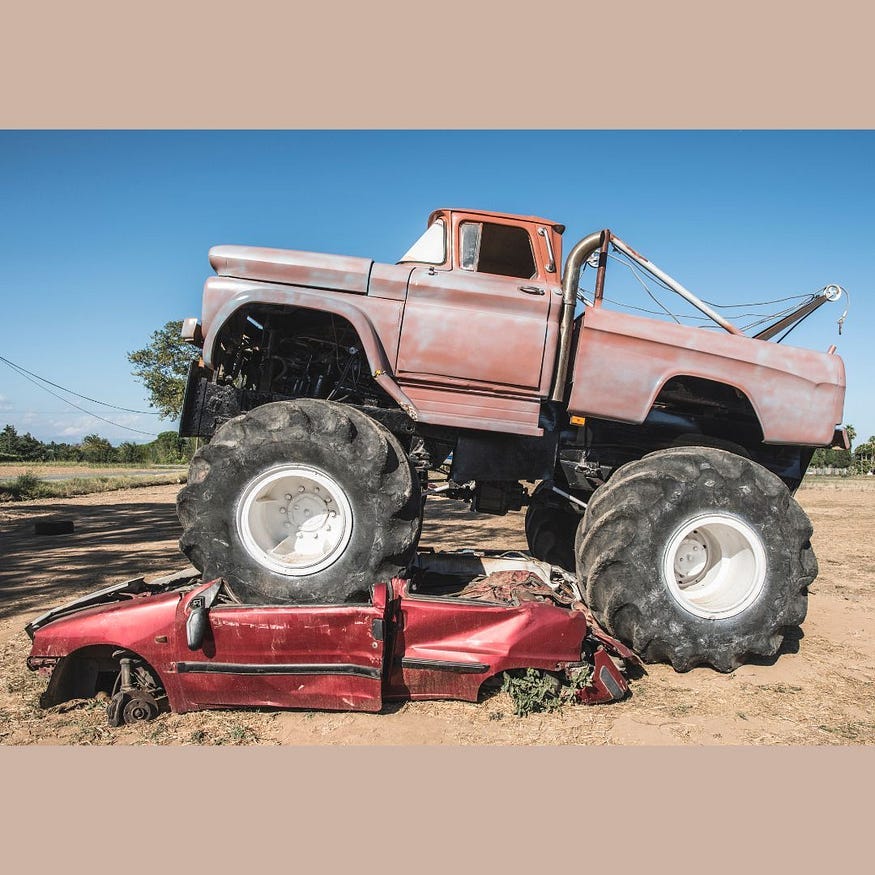Happy National Ugly Truck Contest Day!
But what the f*ck is an ugly truck?

In my book, there’s no such thing as an ugly truck.
There are old ramshackle rusted-out relics of trucks, abandoned and oxidizing, weeds obscuring their tires. But if you’re familiar with the Japanese term, wabi-sabi, you’ll know this is the stuff of prize-winning photos, and respectfully refrain from name-calling.
No. Wabi-sabi is not a form of sushi.It refers to the beauty in everything, especially the rotten and forgotten, the decaying and decrepit, etc. So there’s hope for me yet.
There are trucks putt-putting along that could be driven by The Grapes of Wrath’s Tom Joad, teetering under a mountain of shabby stuff, about to avalanche all over the road.
There are mean, monster trucks that act like they own the road. But that’s not the truck’s fault.
For that you have to look to the driver — -probably some puny guy with a load to dump and an axe to grind — perhaps having to do with his masculinity.
Why else would they have those demolition derbies and wheel-a-wheel crash matches that people pay their hard-earned money to see?
Even if used for nefarious purposes, that doesn’t make the truck ugly — its owner, or driver, perhaps. But again, it’s their soul, not their face that’s blemished.
Why am I defending trucks?
As a kid, I relished Jean Merrill’s story, The Pushcart War.
In this delightful story, set in New York’s Lower East Side, trucks were the enemies. They had personalities, names, and minds of their own, even when the driver climbed down and acted like an asshole. The truck got blamed for running over Freddy the Flower’s daffodil cart.
Spoiler Alert
I rooted for the vendors, recent immigrants all, united against the trucks. They brought commerce and then the city to its knees with their humble weapons — tack-loaded pee-shooters.
Maybe that’s why I tend to root for the underdog. Especially when they’re sidewalk hot-dog vendors, telling puny jokes, winking their wrinkly eyes with an accent and charm born on foreign shores.
Motor vehicles should be banned from neighborhoods like that.
But that’s a people problem.
Cars and trucks are just the vehicles for our class clashes and sidewalk seller bashes. Who buys it and what they use it for is not the truck’s fault.
If they had their druthers, trucks would carry food, medicine, and building materials to where they’re needed the most. Like the truck parked outside the Grand Lake Theater collecting clothes for folks displaced by Hurricane Katrina. Every truck deep down, just wants to serve humanity the best way it can apropos of its horsepower and storage capacity.
Truth be told, they disdain being used as weapons, whether in real life or for public-gouging entertainment. Just because you can’t see their inward cringes, doesn’t mean they aren’t there.
So what’s up with July 20 being National Ugly Truck Contest Day?
When I clicked on National Today, I found this alluring little bit of alliteration.
“A macho man and a massive machine made of molten metals with a masculine demeanor. “
Aside from being impressed with the language, I learned that Gottlieb Daimler, a German automotive pioneer, created the first truck in 1896. And the world, especially our air, has never been the same since.
While the contest’s origins remain shrouded in mystery, National Today did disclose this tidbit.
“By 1996, websites were hosting contests to find the ugliest or strangest trucks. People enter the competition with trucks ranging from ordinary, well-used pickups or vans to ancient wrecks strewn with dents and adorned with art.”
Not in person, where you can see, touch, and smell the noxious exhaust, but online.
Wait. Did they say adorned with art?
That I had to see, and oh my God, so should you.

For a deeper dive into these amazing trucks, check out Hannah Bloch’s NPR story, These Eye-Popping, Hand-Painted Trucks Rule Pakistan’s Roads. Not only do they rule the roads, they perform a great service. To wit:
“Thanks in part to the efforts of M. Khan, the anthropologist and filmmaker, Pakistani trucks don’t only look and sound good — they also serve a social good. She helped launch an award-winning project in 2019 in which a small number of trucks carry portraits of missing children, along with a number to call for Roshni Helpline, a Karachi-based nonprofit dedicated to recovering them.”
So it looks like we’ve gone full circle here. From ugly to artistic, and from demolition demon to humble humanitarian. To quote Oliver Cromwell via Mel Brooks, my work here is done.







